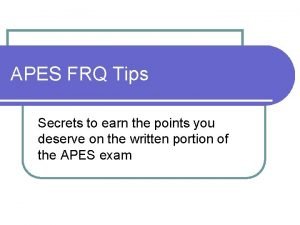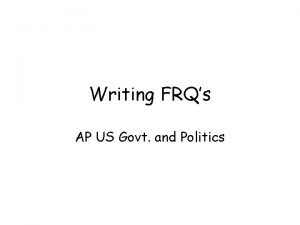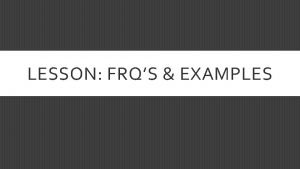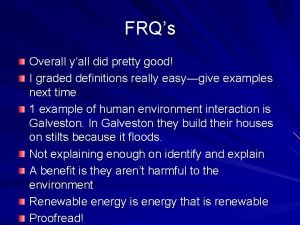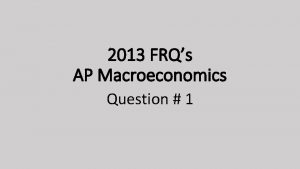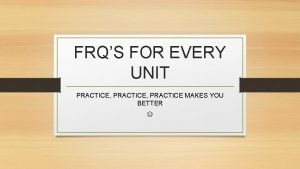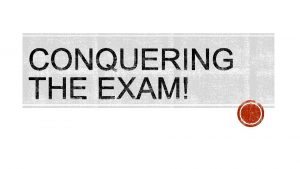Writng the Redesigned FRQs for AP Government and















- Slides: 15

Writng the Redesigned FRQs for AP Government and Politics Combined, the 4 FRQ’s are worth 50 % of your overall grade on the AP Gov exam. Each of the 4 FRQ’s is worth 12. 5% of your grade. Students have 100 minutes total to write the four FRQs. Students can answer the FRQs in ANY ORDER that they choose. College Board recommends that the students spend 20 minutes each on FRQ #1, #2, and #3. It is recommended that the students spend 40 minutes on FRQ #4.

• QUESTION #1 • Always CONTENT APPLICATION • Always 3 points • QUESTION #2 The Format is 100% Predictable • Always QUANTITATIVE ANALYSIS • Always 4 points • QUESTION #3 • Always ANALYSIS OF SCOTUS CASES • Always 4 points • QUESTION #4 • Always ARGUMENTATIVE “ESSAY” • Always 6 points

FRQ #1 CONCEPT APPLICATION � Respond to a political scenario, explaining how it relates to a political principle, institution, process, policy, or behavior.

FRQ #1 CONCEPT APPLICATION •

A good response should: FRQ #1 Scoring the Concept Applica$on Ques$on • Describe a political institution, behavior, or process connected with the scenario (0– 1 point) • Explain how the response in part (A) affects or is affected by a political process, government entity, or citizen behavior as related to the scenario (0– 1 point) • Explain how the scenario relates to a political institution, behavior, or process in the course (0– 1 point)

FRQ #2 QUANTITATIVE ANALYSIS � Analyze quantitative data, identify a trend or pattern, draw a conclusion from the visual representation, and explain how the data relates to a political principle, institution, process, policy, or behavior.

FRQ #2 QUANTITATIVE ANALYSIS •

A good response should: FRQ #2 Scoring the Quan$ta$ve Analysis Ques$on • Identify or describe the data in the quantitative visual (0– 1 point) • Describe a pacern, trend, or similarity/difference as prompted in the question (0– 1 point) and draw a conclusion for that pattern, trend, or similarity/ difference (0– 1 point) • Explain how specific data in the quantitative visual demonstrates a principle in the prompt (0– 1 point)

FRQ #3 SCOTUS COMPARISON � Compare a non-required Supreme Court case with a required Supreme Court case, explaining how information from the required case is relevant to that in the nonrequired one.

FRQ #3 SCOTUS COMPARISON •

A good response should: FRQ #3 Scoring the SCOTUS Comparison Ques$on • Identify a similarity or difference between the two Supreme Court cases, as specified in the question (0– 1 point) • Provide prompted factual information from the specified required Supreme Court case (0– 1 point), and explain how or why that information from the specified required Supreme Court case is relevant to the non-required Supreme Court case described in the question (0– 1 point) • Describe or explain an interaction between the holding in the non-required Supreme Court case and a relevant political institution, behavior, or process (0– 1 point)

FRQ #4 ARGUMENT ESSAY � Develop an argument in the form of an essay, using evidence from one or more required foundational documents.

FRQ #4 ARGUMENT ESSAY •

A good response should: FRQ #4 Scoring the Argument Essay • Articulate a defensible claim or thesis that responds to the question and establishes a line of reasoning (0– 1 point) • Describe one piece of evidence that is accurately linked to the topic of the question (1 out of 3 points); use one piece of specific and relevant evidence to support the argument (2 out of 3 points); use two pieces of specific and relevant evidence to support the argument (3 out of 3 points) • Explain how or why the evidence supports the claim or thesis (0– 1 point) • Respond to an opposing or alternate perspective using refutation, concession, or rebuttal that is consistent with the argument (0– 1 point)

FRQ #4 Tips to Increase Success on the Argument Essay











